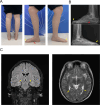Late-Onset Krabbe Disease: Case Report of Two Patients in a Chinese Family and Literature Review
- PMID: 39878400
- PMCID: PMC11775926
- DOI: 10.1002/mgg3.70065
Late-Onset Krabbe Disease: Case Report of Two Patients in a Chinese Family and Literature Review
Abstract
Background: Krabbe disease (KD; globoid cell leucodystrophy) is a rare autosomal recessive lipid storage disorder that affects the white matter of the peripheral and central nervous. Late-onset KD is less frequently diagnosed and often presents with milder symptoms, making accurate diagnosis challenging, especially when distinguishing it from peripheral neuropathy. In this report, we present two cases of late-onset KD in a Chinese family. The first case involves a 25-year-old female who sought treatment due to long-standing spastic gait and deformities in her lower limbs. A muscle biopsy revealed muscle atrophy, and electromyography indicated neurogenic damage. Her 27-year-old sister (Case 2) exhibited similar lower limb weakness, along with more severe central and peripheral neurological symptoms.
Methods: The patients' peripheral blood was retained for galactocerebrosidase (GALC) enzyme activity assaying and whole exome gene sequencing.
Results: GALC enzyme activity assaying showed decreased GALC activity and gene sequencing revealed homozygous mutation of p.L634S (c.1901T>C) in the two cases.
Conclusion: This study broadens the scope for considering of KD in the diagnosis of patients presenting with muscle weakness and deformities in the lower limbs.
Keywords: GALC gene; Globoid cell leukodystrophy; Krabbe disease; case report; late‐onset.
© 2025 The Author(s). Molecular Genetics & Genomic Medicine published by Wiley Periodicals LLC.
Conflict of interest statement
The authors declare no conflicts of interest.
Figures





Similar articles
-
Adult-onset Krabbe disease due to a homozygous GALC mutation without abnormal signals on an MRI in a consanguineous family: A case report.Mol Genet Genomic Med. 2020 Sep;8(9):e1407. doi: 10.1002/mgg3.1407. Epub 2020 Jul 17. Mol Genet Genomic Med. 2020. PMID: 32677356 Free PMC article.
-
A new compound heterozygous mutation in adult-onset Krabbe disease.Int J Neurosci. 2020 Dec;130(12):1267-1271. doi: 10.1080/00207454.2020.1731504. Epub 2020 Feb 25. Int J Neurosci. 2020. PMID: 32064984
-
A novel GALC gene mutation associated with adult-onset Krabbe disease: a case report.Neurocase. 2022 Jun;28(3):314-319. doi: 10.1080/13554794.2022.2083518. Epub 2022 Jun 2. Neurocase. 2022. PMID: 35654103
-
A novel compound heterozygous mutation in GALC associated with adult-onset Krabbe disease: case report and literature review.Neurogenetics. 2022 Apr;23(2):157-165. doi: 10.1007/s10048-021-00682-1. Epub 2022 Jan 10. Neurogenetics. 2022. PMID: 35013804 Review.
-
Two Cases of Female Chinese Adult-Onset Krabbe Disease with One Novel Mutation and a Review of Literature.J Mol Neurosci. 2021 Jun;71(6):1185-1192. doi: 10.1007/s12031-020-01742-1. Epub 2020 Nov 14. J Mol Neurosci. 2021. PMID: 33190188 Review.
References
Publication types
MeSH terms
Substances
Supplementary concepts
Grants and funding
- 2022A1515012334/Natural Science Foundation of Guangdong Province
- 2024A1515012811/Natural Science Foundation of Guangdong Province
- YXQH202202/Sun Yat-sen Scientific Research Project
- YXQH202213/Sun Yat-sen Scientific Research Project
- SYS-5010-202403/Sun Yat-Sen Memorial Hospital Clinical Research 5010 Program
LinkOut - more resources
Full Text Sources
Medical

